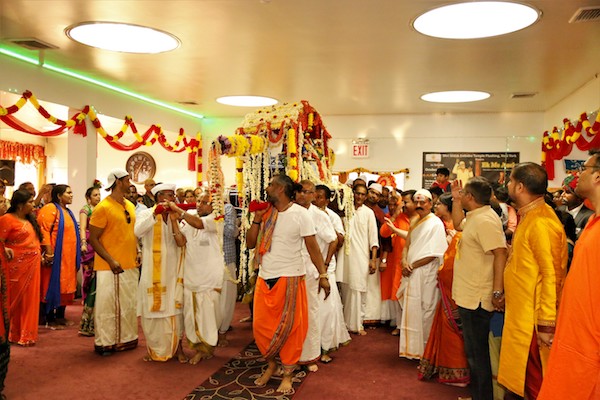
The word ‘Pitr Paksha’ comprises of two words ‘Pitr’ which means ancestors and the ‘Paksha’ which means phase of the moon. The auspicious period in the dark fortnight of Ashwina (September-October) is known as Pitr Paksha or Mahalaya Paksha. It is a 16-lunar day period and is also known as Pitri Pokho, Pitru Paksya, Sola Shradha, Kanagat, Jitiya and Apara Paksha. This is an occasion to pacify the departed ancestors by performing rites to repay debts to the ancestors.
Pitr Paksha is observed from the Ist day or Tithi of the Ashwin month and continues till the following new Moon day(Amavysya) which is known as Sarvapitri Amavysya, Mahalaya Amavysya or simply Amavysya. During this period of 15 days, the Shraddha or Tarpan of the ancestors is performed on the Tithi on which they met eternity. Apart from this, each day is dedicated to the Tarpan of all the ancestors in this period. This period starts from 12 September 2011 and ends on 27 September 2011 this year.
Legend
According to Hindu mythology, the souls of three preceding generations of one’s ancestor reside in Pitru-loka, a realm between heaven and earth. This realm is governed by Yama, the god of death, who takes the soul of a dying man from earth to Pitru-loka. When a person of the next generation dies, the first generation shifts to heaven and unites with God, so Shraddha offerings are not given. Thus, only the three generations in Pitru-loka are given Shraddha rites, in which Yama plays a significant role. According to the sacred Hindu epics (Itihasa), at the beginning of Pitru Paksha, the sun enters the zodiac sign of Virgo (Kanya). Coinciding with this moment, it is believed that the spirits leave Pitru-loka and reside in their descendants’ homes for a month until the sun enters the next zodiac-Scorpio (Vrichchhika)-and there is a full moon. Hindus are expected to propitiate the ancestors in the first half, during the dark fortnight.
When the legendary donor Karna died in the epic Mahabharata war, his soul transcended to heaven, where he was offered gold and jewels as food. However, Karna needed real food to eat and asked Indra, the lord of heaven, the reason for serving gold as food. Indra told Karna that he had donated gold all his life, but had never donated food to his ancestors in Shraddha. Karna said that since he was unaware of his ancestors, he never donated anything in their memory. To make amends, Karna was permitted to return to earth for a 16-day period, so that he could perform Shraddha and donate food and water in their memory. This period is now known as Pitru Paksha.In some legends, Yama replaces Indra.
Significance
According to the Hinduism, the body is destructible but a soul is eternal. It can neither be created nor can be destroyed. Lord Krishna in Bhagwat Gita says, “for the soul there is neither birth nor death at any time. The soul is unborn, eternal, ever existing and primeval. It is not slain when the body is slain.” The Pitra Paksha rites liberate a soul from the vicious circle of life and death and it attains salvation. The Shraddha of Pitra Paksha involves oblations to three preceding generations by taking their names and also by taking name of the family tree or Gotra.
These rites are performed by current generation to repay the debts of ancestors. It is said that ancestors(Pitrs), gods(Devas) and ghosts(Pretas) when are propitiated bestow health, wealth, wisdom, longevity and eventually salvation.
Legend of Pitr Paksha
Hindu mythology says that there exists a zone between heaven and earth which is known as Pitr-Loka. All the ancestors or Pitrs dwell at this place. This zone is governed by Yamadeva or god of death. The person of first generation goes to heaven only when the person of second generation dies and hence the death rites or Shraddha for the person of first generation are not completed. Therefore, in Pitr Paksha the Shraddha of ancestors of three preceding generations is done to propitiate them.
It is believed that Sun enters zodiac sign of Virgo at the beginning of this period. On this day, the departed souls of ancestors or forefathers leave the Yamaloka or abode of Yama and descend to earth to acknowledge the rites performed by their descendants untill the Sun enters next zodiac sign which is Scorpio.
Time and Place of Shraddha
The Shraddha or Tarpana of the ancestors is performed on the Tithi on which they died but there are certain exceptions to it. The fourth day or Chautha Bharani and the fifth day or Baharani Panchmi is allotted for people who died in the previous year. Avidha Navami is for married women who died before their husbands. Ghata Chaturdashi is for people who died in a sudden and violent death. The Mahalaya or Sarvpitri Amavysya is for all the ancestors and forefathers.
A descendant usually performs Shraddha or Tarpana at his home but people perform these rites at pilgrimages like Gaya, Allahabad and Kashi also.
Rituals of Shraddha
The rituals of Shraddha are generally performed by an eldest son or an eldest male member of the family. He wears a Dhoti in the morning after taking bath. He also wears a ring of Kusha grass. The male performing Shraddha should have gone through the sacred-thread ceremony as the position of sacred-thread needs to be changed several times during the rites. After that, oblations are given to ancestors(Pitrs) and gods(Devas) which is known as Tarpana. The Shraddha ritual also involves Pinda-Dan which is an offering to the ancestors in the form of balls of cooked rice, barley and ghee. A grand meal is prepared which is offered to cow, dog, crow and insects. The Brahmins are fed and are offered alms. The whole family eats the food as Prasada after this whole process is completed.





Be the first to comment